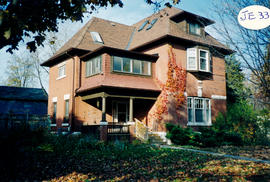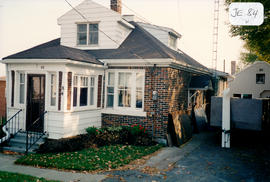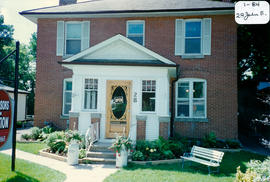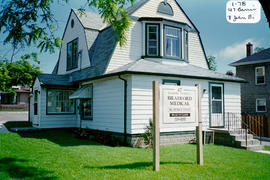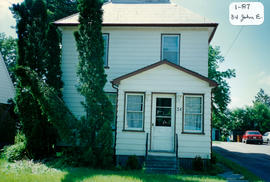33 John Street East - The Dr. Lewis Campbell House
- CA BWGPL GJ-HB-2017-04-04-06
- Unidad documental simple
- 1995
Parte deGeorge Jackson fonds
The Dr. Lewis Campbell House is a mid-block building located at 33 John St. East. It was built in 1900 in the Eclectic Edwardian style. Dr. Lewis H. Campbell was a well-known physician, athlete, and field lacrosse player. He travelled with the local lacrosse team to Australia (where they were undefeated). The team continued playing in India and Europe before coming back home. He had the house (and his office) built here the summer he got married. He married a nurse after his first wife’s early death and continued to live and practise here until his own death. The house was then sold to another doctor. Originally there was a full, two-storey horse stable with a loft behind the house. On the south-west corner there was a room for storing harnesses, blankets, etc. This faced the back lane and was clapboard with a peaked, metal roof. At the rear of the house there was also a brick, one-storey garage and storage for a cutter, buggy, etc. It was on the north side of the laneway and was later made into a small house with a verandah closed in on the south side for Kowalchuch (a small market gardener) and his family of two girls.
The 2½-storey house has an ‘L’-shaped plan (a Gothic feature). The steeply-pitched, hip roof has a large, hipped dormer. There is a large, projecting, second-floor bay window with a balanced window opening at the ground floor. Classically-inspired colonnettes on brick and stone piers at the porch entrance are another Edwardian feature. The eaves line is not consistent. Front, projecting roof eaves are higher than at the rear of house. This is more typical of an Arts and Crafts detail. The entrance door has sidelights and the double-hung windows have decorative, multi-pane, upper-sash windows. There are rusticated stone highlights at the belt course, ground floor window sills and porch colonnettes bases at the front façade. The house has brick masonry construction. A balcony infill above the porch does not appear to be original. The roof skylight and replacement entrance stairs and railing are also modern additions. According to the 2000 inventory, the house is unique and grand, with an eclectic mix of many original details. It also notes that it was difficult to see the structure due to the surrounding trees. (1, 2, 3)
Sin título

